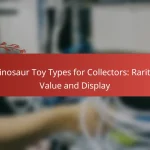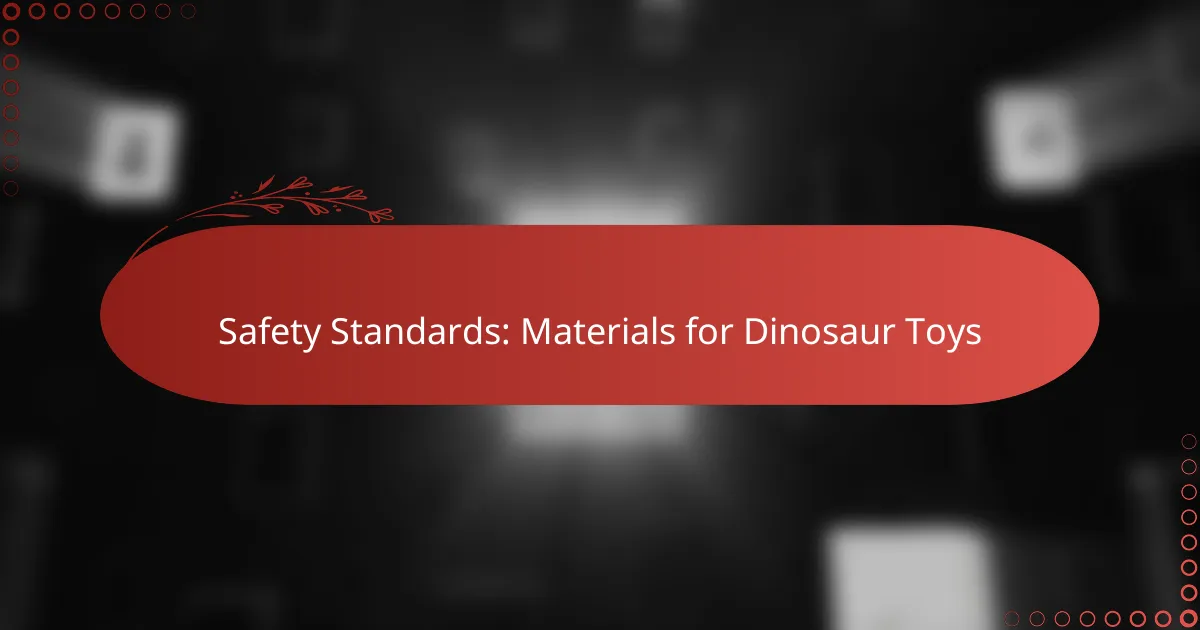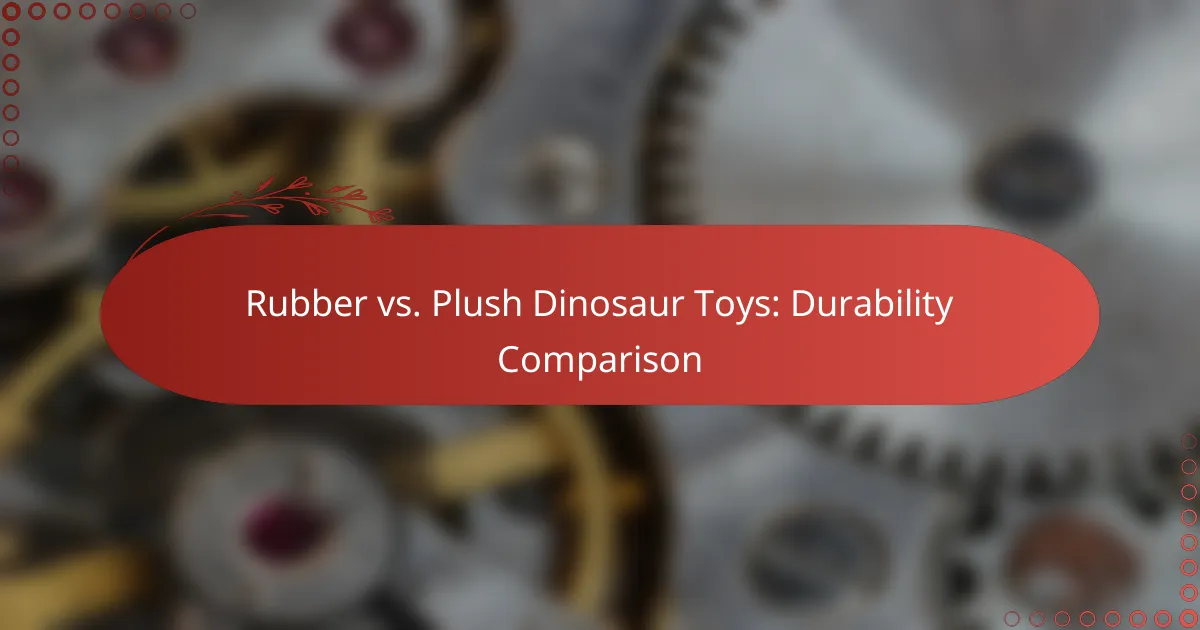When choosing dinosaur toys for children, the material used plays a crucial role in safety, durability, and cost. While plastic is often more affordable and durable, it may contain harmful chemicals, making wood a safer and more eco-friendly alternative. Parents should weigh these factors carefully to ensure they select the best option for their child’s playtime experience.

How do plastic and wood materials affect dinosaur toy safety?
The safety of dinosaur toys is significantly influenced by the materials used, with plastic often posing risks due to harmful chemicals, while wood tends to be a safer, more eco-friendly option. Parents should consider these factors when selecting toys for their children.
Plastic toys may contain harmful chemicals
Many plastic dinosaur toys are made with materials that can release harmful chemicals, such as phthalates and bisphenol A (BPA). These substances can pose health risks, especially to young children who may put toys in their mouths.
When purchasing plastic toys, look for labels indicating compliance with safety standards, such as ASTM or EN71, which help ensure that the products are free from toxic substances. Opting for toys made from high-quality, non-toxic plastics can also reduce potential hazards.
Wood toys are often more eco-friendly
Wooden dinosaur toys are generally considered safer and more environmentally friendly compared to their plastic counterparts. They are often made from sustainably sourced wood and are less likely to contain harmful chemicals.
Choosing wooden toys can contribute to a healthier play environment for children. However, it’s essential to ensure that the wood is treated with non-toxic finishes and paints to maintain safety standards. Look for certifications like FSC (Forest Stewardship Council) to ensure responsible sourcing.

Which material offers better durability for dinosaur toys?
Plastic generally offers better durability for dinosaur toys due to its higher impact resistance compared to wood. While both materials have their advantages, plastic tends to withstand rough play and drops more effectively.
Plastic provides higher impact resistance
Plastic toys are designed to absorb shocks and resist breaking when dropped or thrown. This makes them ideal for children who may not handle toys gently. Many plastic dinosaur toys are made from materials like ABS or PVC, which are known for their toughness.
Moreover, plastic can be molded into intricate designs, allowing for detailed features without compromising strength. This durability means that plastic toys can last longer, making them a cost-effective choice for parents.
Wood can splinter but is often sturdier
Wooden dinosaur toys, while potentially more prone to splintering, can be sturdier overall due to the natural strength of the material. High-quality wood, such as hardwoods, can withstand significant wear and tear, making them a durable option for play.
However, it’s essential to inspect wooden toys regularly for any signs of splintering or damage. Choosing toys that are well-finished and treated can minimize these risks, ensuring safety during playtime. Additionally, wooden toys often have a timeless appeal and can be passed down through generations.
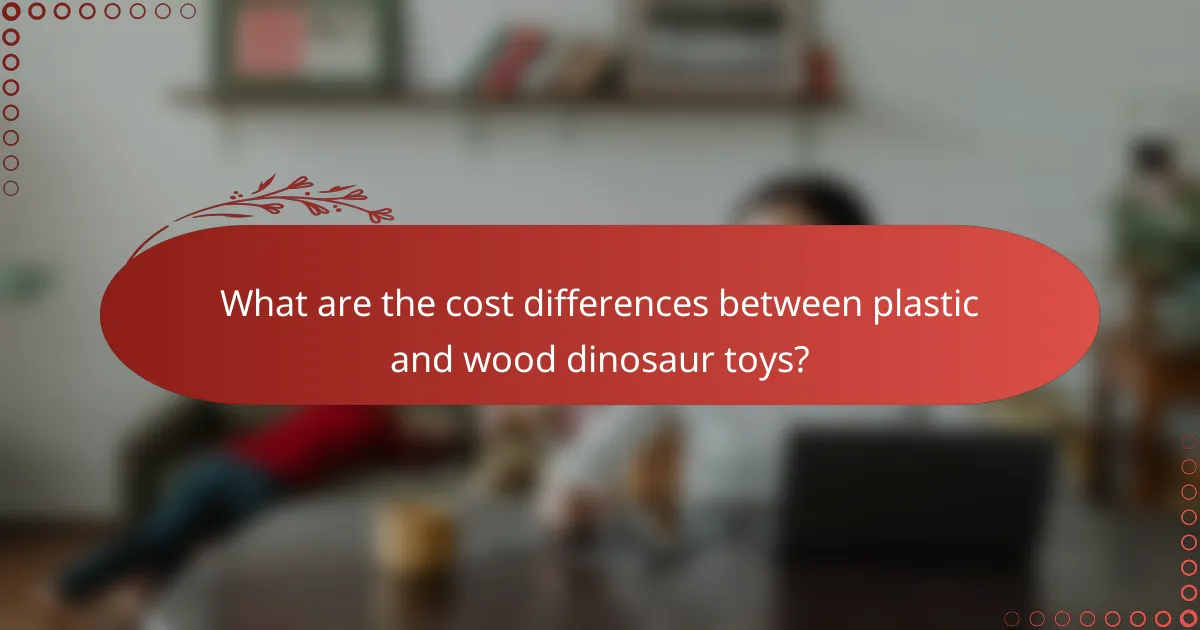
What are the cost differences between plastic and wood dinosaur toys?
The cost differences between plastic and wood dinosaur toys can be significant, with plastic options typically being more affordable than their wooden counterparts. Factors such as production methods, material sourcing, and durability contribute to these price variations.
Plastic toys are generally cheaper
Plastic dinosaur toys are often produced in large quantities, which helps reduce manufacturing costs. Prices for these toys can range from a few dollars to around twenty dollars, making them accessible for most budgets.
Additionally, plastic toys are lightweight and easy to transport, which further lowers shipping and handling expenses. This affordability makes plastic a popular choice for parents looking to buy multiple toys for their children.
Wood toys often have a higher price point
Wooden dinosaur toys usually come with a higher price tag due to the cost of raw materials and the craftsmanship involved in their production. Prices for wood toys can start around ten dollars and go up to fifty dollars or more, depending on the design and quality.
Moreover, wood toys are often marketed as more durable and eco-friendly, which can justify their higher cost. Parents may be willing to invest more in wooden toys, believing they offer better longevity and a safer play experience for their children.

How do plastic and wood materials impact play experience?
The choice between plastic and wood materials significantly influences the play experience of dinosaur toys. Each material offers distinct advantages and drawbacks that can affect children’s engagement, safety, and sensory interaction.
Plastic toys are lightweight and colorful
Plastic dinosaur toys are often designed to be lightweight, making them easy for young children to handle and manipulate. Their vibrant colors attract attention and stimulate imaginative play, allowing kids to create dynamic scenarios.
Additionally, plastic toys can be produced in various shapes and sizes, providing a wide range of options for play. However, parents should consider the quality of the plastic; opting for toys that meet safety standards, such as those free from harmful chemicals like BPA, is crucial.
Wood toys provide a tactile, natural feel
Wooden dinosaur toys offer a tactile experience that many children find appealing. The natural texture and weight of wood can enhance sensory play, allowing kids to explore different feelings as they interact with their toys.
Moreover, wood is often seen as a more environmentally friendly option compared to plastic, as it is biodegradable and typically sourced from sustainable forests. However, wooden toys may be heavier and less colorful than their plastic counterparts, which could limit some aspects of imaginative play.

What are the environmental impacts of plastic vs. wood dinosaur toys?
The environmental impacts of plastic and wood dinosaur toys differ significantly. Plastic toys contribute to long-lasting waste in landfills, while wood toys offer a more sustainable option due to their renewable and biodegradable nature.
Plastic contributes to long-term waste
Plastic dinosaur toys are often made from petroleum-based materials, which do not decompose easily. As a result, they can persist in the environment for hundreds of years, contributing to the growing problem of plastic pollution.
When discarded, plastic toys can break down into microplastics, which can harm wildlife and ecosystems. Many countries are implementing stricter regulations on plastic waste, encouraging consumers to consider alternatives that are less harmful to the environment.
Wood is renewable and biodegradable
Wooden dinosaur toys are typically crafted from sustainably sourced timber, making them a renewable resource. When a wooden toy reaches the end of its life, it can decompose naturally, returning nutrients to the soil.
Choosing wood over plastic not only reduces waste but also supports sustainable forestry practices. Look for toys certified by organizations like the Forest Stewardship Council (FSC) to ensure that the wood is sourced responsibly.
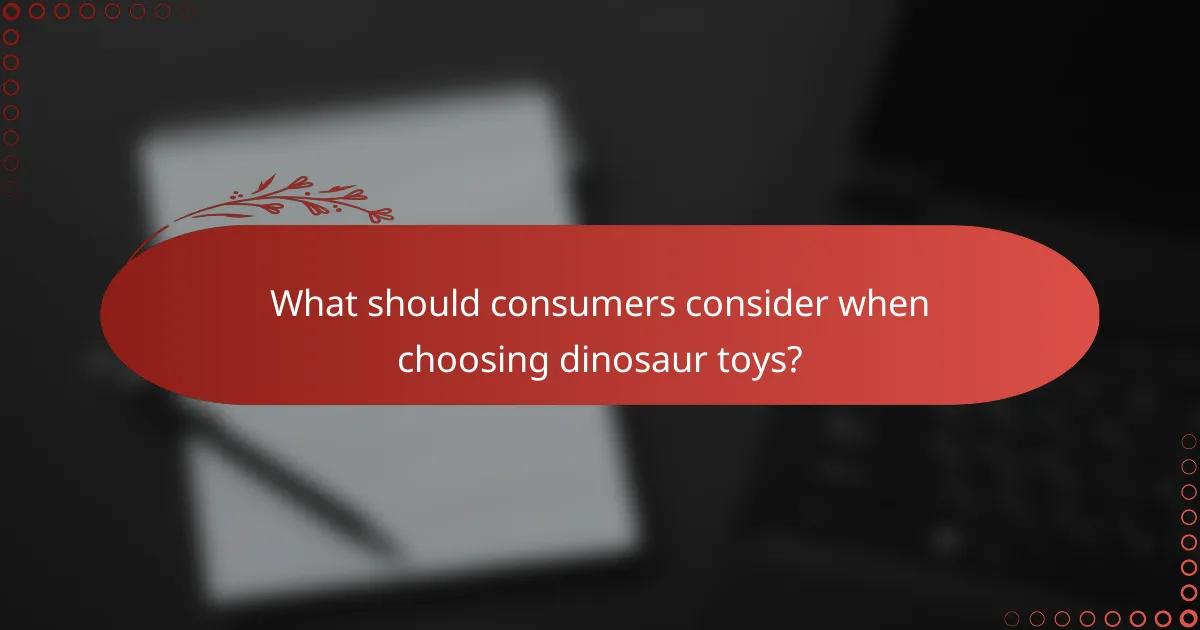
What should consumers consider when choosing dinosaur toys?
Consumers should prioritize safety, durability, and material quality when selecting dinosaur toys. Understanding the differences between plastic and wood can help in making informed choices that ensure both enjoyment and safety for children.
Assess safety certifications for materials
When choosing dinosaur toys, it’s crucial to check for safety certifications that indicate the materials used are non-toxic and safe for children. Look for labels such as ASTM, CPSIA, or EN71, which signify compliance with safety standards in the U.S. and Europe.
Additionally, be aware of potential hazards associated with certain materials. For instance, some plastics may contain harmful chemicals like phthalates or BPA, while wooden toys should be treated with child-safe finishes. Always verify the source and manufacturing practices of the toy.
Evaluate the longevity of the toy
Longevity is an essential factor when selecting dinosaur toys, as it impacts both the toy’s value and its environmental footprint. Generally, wooden toys tend to last longer than plastic ones, making them a more sustainable choice over time.
Consider how the toy will withstand wear and tear. High-quality plastic toys may last several years, but they can become brittle or fade with prolonged exposure to sunlight. In contrast, well-crafted wooden toys can endure rough play and often come with a timeless appeal that can be passed down through generations.
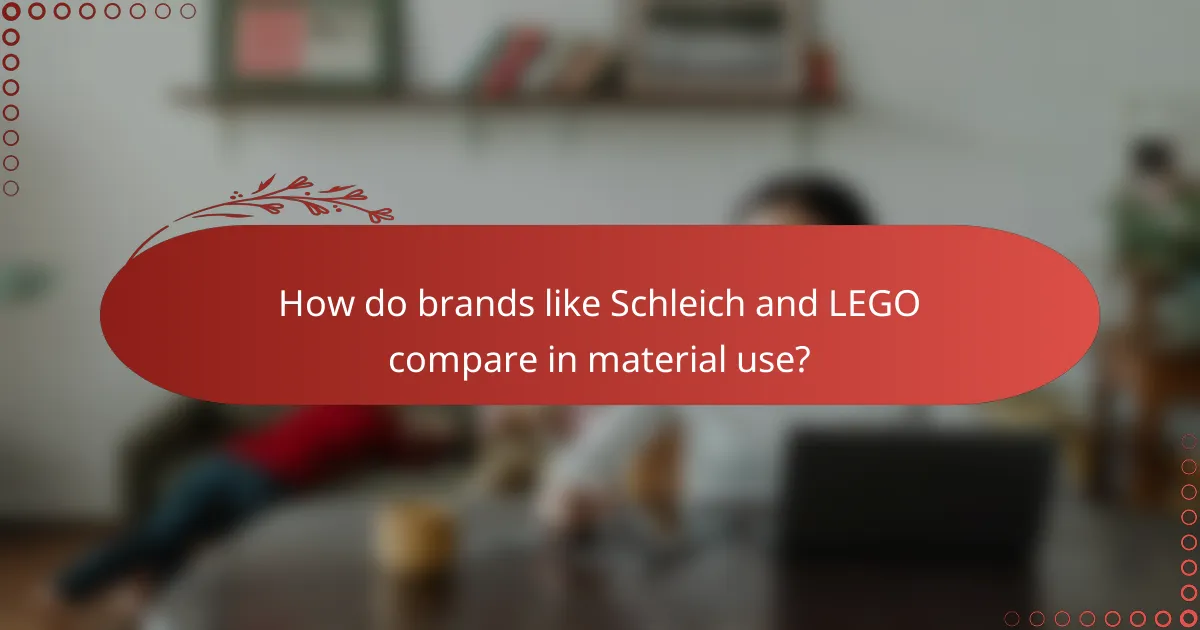
How do brands like Schleich and LEGO compare in material use?
Brands like Schleich and LEGO utilize different materials for their dinosaur toys, with Schleich focusing on high-quality plastic for intricate designs while LEGO offers a mix of plastic and wood options. This choice impacts durability, detail, and environmental considerations.
Schleich uses high-quality plastic for detail
Schleich is known for its commitment to detail, using high-quality plastic that allows for intricate designs and realistic textures in their dinosaur figures. This type of plastic is often durable and can withstand rough play, making it suitable for children.
Additionally, Schleich adheres to strict safety standards, ensuring that their plastic is free from harmful chemicals. This focus on quality not only enhances the visual appeal of their toys but also contributes to their longevity in a child’s toy collection.
LEGO offers both plastic and wood options
LEGO provides a unique approach by offering both plastic and wood materials in their dinosaur-themed sets. The traditional LEGO bricks are made from durable plastic, which allows for versatile building and creativity.
In contrast, LEGO’s wood options are often found in their more eco-friendly lines, appealing to parents looking for sustainable choices. These wooden pieces may not have the same level of detail as plastic but offer a different tactile experience and are often seen as a safer alternative for younger children.

What are the trends in dinosaur toy materials?
Trends in dinosaur toy materials are shifting towards a mix of plastic and wood, with a growing emphasis on sustainability. Manufacturers are increasingly exploring eco-friendly options to meet consumer demand for greener products.
Increasing demand for sustainable materials
The demand for sustainable materials in dinosaur toys is on the rise as consumers become more environmentally conscious. Parents are seeking toys made from renewable resources, such as wood, which can be sourced sustainably and have a lower carbon footprint compared to traditional plastics.
Wooden dinosaur toys often appeal to parents due to their durability and natural aesthetic. However, they can be more expensive than plastic alternatives, which may deter some buyers. It’s essential for manufacturers to balance cost with sustainability to attract a broader market.
Incorporating recycled plastics is another trend gaining traction. These materials can reduce waste and lower the environmental impact of toy production. Companies that utilize recycled content often highlight this in their marketing to appeal to eco-aware consumers.


